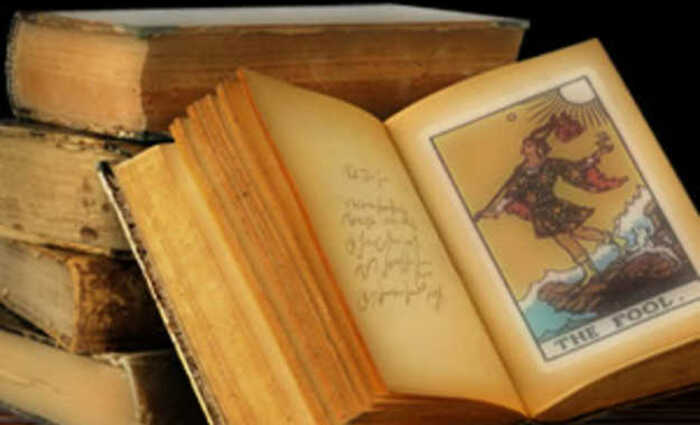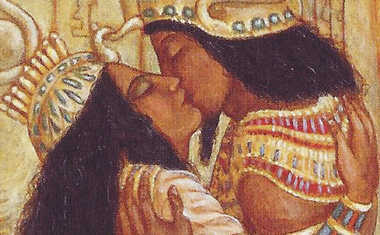
Albigensian Crusade
Read through Tarot's most important crusade
Part IV: Albigensian Crusade and the Inquisition
The "problem" of the Cathari was solved by the Albigensian Crusade. Without going into irrelevant details, the Cathari in Provence (called Albigensians after the town of Albi) were preaching the downfall of the Church under the protection of powerful local rulers who were snubbing their noses at the Pope. When they murdered a Papal Legate, the pope went anaerobic and called on the rulers of northern France to intervene. More motivated by greed than obescence to the pope, the rulers of Northern France had a terrific excuse to move in and take over the rich agricultural properties and Mediterranean ports. Atrocious as it was, it was nonetheless successful and the infrastructure of the heresy was demolished in southern France.
Is this person worth your time and energy? Get answers now with a Live Psychic Reading.
Why do the same people keep showing up in your life? Find out with an intuitive reading today.
The Albigensian Crusade (1207-1244) and its aftermath removed a ruling class and brought about a massive transfer of power, which in turn opened the way to sustained and effective persecution (Lambert, 1998). The Inquisition was invented to eradicate the remnants that went underground. The last resurgence of Cathari in Languedoc was Pierre Autier (1299-1310). Interestingly, to cover his preaching, Autier carried a bunch of Parma knives for sale (Lambert, 1998) suggesting the Bateleur card. In 1326 at Carcassonne, the last Cathar in France was burned (Leff, 1967). As far as we know, the heresy ceased to exist in Provence.
But the Cathari probably didn't originate in Provence, and they certainly didn't end there. We know that the Provencal Cathari maintained communications with the Bulgarian Bogomils, and it is possible that many migrated there, where the dualist religion continued to flourish under sympathetic rulers. But there was a refuge much closer to home in the powerful city-states of northern Italy. We don't know where Catharism first emerged as a fully developed religion. But as early as 1028, heretics very similar to Cathars were noted near Milan (Little, 1988), and the second report of fully developed Catharism was 1179 near Milan, shortly after they were reported in Cologne in 1143. We also know that when the Bogomil initiate, Nicetas, visited the west in 1167, he first visited the communities in Italy and then moved on to Provence. So Catharism is about as old, and even possibly older, in northern Italy.
And while the pope could encourage the northern French rulers to overrun Provence, he had no such option in Italy because the city-states were too powerful. The city-states were very jealous of their autonomy and viewed the pope as a rival for political power and control. As a result, they had a long tradition of anti-clericalism and had long struggled with the pope and bishops over the rights, liberties and endowments of the Church (Lambert, 1998). So by 1250, one of the largest communities of practicing Cathari was in communes clustered around Milan (Runciman, 1947). Ferrara, where the Tarot is first mentioned in 1442, had a particularly active Cathar community (Davison, 1927). In Viterbo, under protection of Giovanni Tignosi, a heretic pope was elected in 1231.
In many cases, the city officials were not so much sympathetic to Catharism as they were reluctant to yield to the church in passing anti-heretical laws and didn't want to set the inquisitors loose after their behavior in France. So, for example, in 1260 Pallaviciono became prefect in Milan and prohibited the Inquisition from operating there (de Salvio, 1936). In 1322, the synod of Valence condemned Matteo Viscounti as a heretic because he rescued and harbored Cathari. The port of Genoa, easily reached from the Provencal coast, was another place of refuge (de Salvio, 1936). The records of the Grand Inquisitor Bernard Gui in the early 14th century also mention that Italy was a haven of refuge for the Provencal Cathari. Two leading families in Florence (Nerli and De Barone) had a Perfecta in their family (Lambert, 1998).
The liberal atmosphere in Italy can be seen in the story of Princess Blazena Vilemina, daughter of King Premysl Ottokar I of Bohemia and his queen, Constance of Hungary. Known as Guglielmina, she came to Milan about 1260 (Newman, 1995). She wasn't a Cathar though she may have been influenced by the Brethren of the Free Spirit, a similar sect in northern Europe (Vaneigem, 1998). Although her followers proclaimed her to be the Incarnation of the Holy Spirit, she wasn't generally regarded as a heretic and four local churches had paintings of the "saint." An altarpiece at Biassono depicts the Trinity with Jesus and Gugliemina sitting side by side (Newman, 1995). Moakley (1966) suggested that one of her followers, Maifreda da Pirovano, cousin of Matteo Visconti, was the model for the Papess card in the Viscounti-Sforza deck. She was indeed elected Pope by the sect.
However, by the end of the thirteenth century, the situation began to change. Some of the Cathari's most powerful patrons and protectors lost political power, and they were reduced to a clandestine existence (Lambert, 1998). The last bishop was arrested in Figlione in 1321, and the last Cathar detected in Florence was in 1342. In 1387-9 Inquisitors discovered Catharism in the valleys of the Alps, working in intense secrecy, meetings at night, imposing oaths against betrayal, using secret sign of recognition, "pressing little fingers together". In Lombardy, the city states, like Milan, Genoa, Verona, Venice, and Florence, maintained Cathar hiding places into the 15th century (Leff, 1967). In 1412, the end of Catharism was marked by digging up 15 dead heretics and burning their bodies (Lambert, 1998). After this, the religion as a public entity only existed in Bosnia.
The fatal flaw that caused the death of Catharism was the critical role of the Perfecti and their vulnerability to detection. Without the Perfecti to administer the deathbed consolamentum, the ordinary Cathar believer is reduced to hopelessness--there is no means for salvation, and Catharism makes no sense. And in the growing commercial atmosphere of the Italian cities, with their intimate dissected neighborhoods, it became impossible to hide a celibate vegetarian who had taken a vow of poverty!
So why couldn't the Perfecti blend in, pretending to be married and eating meat only in public? Because even a casual touch from the opposite sex was a sin. With that sin, the Perfecti lost their status as initiates and their power to administer the deathbed consolamentum. They would have to be re-confirmed and receive a new consolamentum each time this occurred. So by their own doctrine, it was practically impossible to "blend in." In addition, literacy had waned among the Perfecti during the 14th century (Lambert, 1998), and lines of communication between groups became minimal or non-existent. Without written documents and with little opportunity to communicate or reinforce an oral tradition, the elegance of the original theology stood little chance even if an individual "Perfect" could be hidden by sympathetic families and neighborhoods.
So could the Tarot, which appears for the first time in Ferrara in 1442, be a direct legacy of the Cathari? Well, it is possible--but it is a stretch. Catharism maintained itself in small secret groups, and it is conceivable that remnants of these still existed by the time the Tarot appears. So it is far more likely that the contribution of Cathar dualism to the Tarot was indirect--it passed through other hands in the later stages.
As we will see in the next few sections, the remnants of Catharism were not so much eradicated as transformed. In the transformation, much of the distinctive Cathar dogma inherited from the Bogomils was lost. However, much of the spirit of the heresy was retained. Also, much of the everyday practice and idealism survived. The story of how the spirit and practice of Cathar dualism might have influenced the Tarot is utterly fascinating, but it will require a couple of dry historical chapters to establish the background and present the story.
References
Davison, E. S. 1927. Forerunners of Saint Francis. Houghton Mifflin, NY.
de Salvio, A. 1936. Dante and Heresy. (Reprinted 1975 by Books for Libraries).
Lambert, M. 1998. The Cathars. Blackwell, Oxford.
Leff, G. 1967. Heresy in the Later Middle Ages: The Relation of Heterodoxy to Dissent c. 1250-1450. Manchester Univ Press, Manchester.
Little, L. K. 1988. Liberty, Charity, Fraternity: Lay Religious Confraternities at Bergamo in the Age of the Commune. Smith College, Northampton, Massachusetts.
Moakley, G. 1966. The Tarot Cards. New York Public Library, N.Y.
Newman, B. 1995. From Virile Woman to Woman Christ. University of Pennsylvania Press, Philadelphia.
Runciman, S. 1947. The Medieval Manichee. Cambridge University Press, Cambridge. (Reprinted 1996).
Vaneigem, R. 1998. The Movement of the Free Spirit. Zone Books, NY (orig 1986 Editons Ramsey, France).



